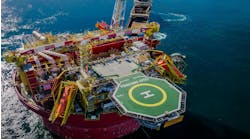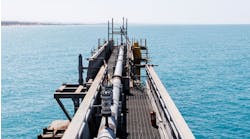Demonstration of the shower of sparks generated by ABB Gas Technology's flare gas ignition system to ignite the gas cloud at the flare tip.
ABB Gas Technology is attracting incr-easing interest for its flare gas ignition system, now in operation on some 15 platforms in the Norwegian sector and other installations around the world. In combination with a flare gas recovery system, the technique provides a solution to the problem of continuous flaring, which is not only harmful to the environment, but as oil companies are increasingly realizing, equivalent to watching money go up in flames. Ever-tighter restrictions on greenhouse gas emissions also help to enhance the technology's attractions.
The combination of the flare gas ignition and recovery systems enables platforms to operate without a continuous flare. When a process upset occurs, gas is diverted to the flare, which is lit via the ignition system. This means that gas flaring need only occur when required for safety reasons, according to Morten Sivertsen, sales manager for ABB Gas Technology.
It is not even necessary to keep a pilot flare alight. Significant volumes of gas - typically 1-3 MMcm/d - can instead be exported for sale or used for power generation.
Flare system
The flare gas ignition system was originally developed by Umoe Process Technology, which was absorbed into ABB Gas Technology when ABB took over the Umoe group last year. It provides a flexible solution which can be retrofitted on existing platforms or designed into new installations. It can be operated either manually or automatically, is suitable for all flare tips, works in all weather conditions, and does not involve any electronics in areas of high heat radiation, Sivertsen says.
The latest development is USIS 2000, which enables flares up to 2,000 meters distant to be ignited. It can therefore be used to light flares at some distance from the control location. When gas in the process system reaches a critical pressure, a fast-opening valve is activated allowing gas to pass to the flare tip.
At the same time, an air-driven ignition pellet is launched through a guide pipe to the flare tower. On exiting the guide pipe, the pellet bursts, generating a shower of sparks directed towards the flare tip, which instantly ignites the gas cloud.
The guide pipe can be installed subsea. The first such installation is due to take place this month on Occidental's TP1 platform in Qatar. Offshore Newfoundland, the system has been installed on Mobil's Hibernia platform.


